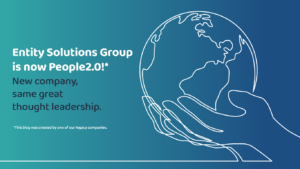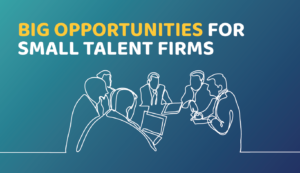As businesses try to emerge in a post-pandemic world, they ponder one existential question: “How do we do that?”. While some wait to see if the economy becomes more stable, others grasp the challenge with both hands and look at growth opportunities.
In the second webinar of our series for small businesses and recruitment agencies, James Atkins (Vantage Strategy) shares how organisations can grow and highlights the role played by innovation in pivoting towards a more prosperous future for the company, its clients, and its staff.
This webinar summary will focus on the REGROW phase in a post-pandemic world, and you can watch the full webinar recording below.
Start with reflection
Organisations should contemplate the following questions:
- What is your go-to-market strategy?
- What constitutes your future success?
- What will your competitive edge be?
- Who are your key future customers?
- What is your value proposition?
- What role will innovation play in your business?
Innovation refers to incremental or radical changes that are either sustaining or disruptive to your operation. These changes must add real value to candidates and clients, and their implementation must lead to growth for your business.
Knowing where to scope out opportunities in your market
Atkins starts by setting a practical one-line definition for innovation as “a change that adds value and can be monetised”. Whether sustained or disruptive such innovation can be defined at the edges and the intersections of clients, candidates, services, and competition; it follows the diffusion of innovation cycle and should be assessed within a defined PESTLE context. He then expands on the concepts to include digital transformation to enhance both the customer and staff experiences.
Innovative leaders
Innovative leadership is another critical aspect for success. Innovative leaders should be able to ask powerful questions, observe target clients, communicate with others outside of the organisation, experiment regularly, and balance growth and risk. The innovative leader should also know the importance of setting the right culture for innovation.
Leaders that drive innovation exhibit four behaviors, including:
- Asking powerful questions
- Observing their target clients with a keen interest
- Speaking with others outside of the organization
- Experimenting quickly and often.
How to adapt your business/services
Throughout the webinar, multiple tools are discussed. The BCG Product Life Cycle curve is a tool organisations use to identify emerging opportunities to innovate in the product life cycle. The Ansoff Matrix demonstrates four different ways to grow market innovation, naming Market Penetration, Market Development, Product Development, and Diversification.
The Product Surround Model enables businesses to unpack the needs and problems of their clients and build products and services around them. For example, 80% of recruitment costs result in only 20% impact for the clients. Companies ought to think about how to add value beyond the clients’ core business.
How to find your competitive advantage
A Sustainable Competitive Advantage (SCA) is a model that provides value to the clients, beats competitors, and possesses an internal impact. Moreover, adopting a customer-centric approach helps improve customer experience and the bottom line. High emotional connections are essential in creating higher value engagements with clients.
Five killer questions that organisations should reflect on include:
- Simplify: What direct costs or complexity in the business model can you eliminate without having an impact on the clients?
- Augment: How can you use technology to delight customers and create a point of difference?
- Leverage: How can you leverage your people/teams more effectively to deliver better customer experience?
- Stop Doing: What activities that add no value to the end customers will you stop doing?
- Capability: What skills will you need to remain valuable to target clients?
It is also critical that organisations aim to tackle all four dimensions of customer experience: BRAND Experience, PRODUCT Experience, BUYING Experience and SERVICE Experience.
Greatest barriers to growth & how to overcome them
Finally, bureaucracy and complexity are the two main barriers to growth. The Seven Waste Model helps to address the concept of ‘waste’ in in the business, where even non-fully utilised talent can hinder growth.
- Bureaucracy: assess how bureaucracy might hinder growth in your organisation in terms of speed, motive, time, decisions and information.
- Complexity: determine where wastes can be removed using the Seven Waste
- Overproduction: is production more than what is required?
- Waiting: is there too much waiting time between activities in a process?
- Transporting: can transport now be digital?
- Inappropriate Processing: are there face-to-face tools that do not work digitally?
- Inventory: is your working progress too big?
- Motions: are there unnecessary motions in workplace?
- Defects: where are the delays or re-work in your delivery?
- Non-Utilised Talent: who are the hidden talents that might be able to assist in mitigating these wastes?
Watch James Atkins of Vantage Strategy address other hot topics:
How to develop business resilience for the future
Leading teams in times of change



